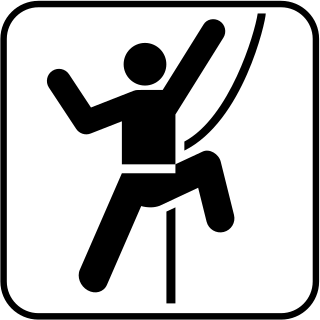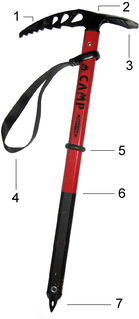
Climbing is the activity of using one's hands, feet, or any other part of the body to ascend a steep topographical object. It is done for locomotion, recreation and competition, and within trades that rely on ascension; such as emergency rescue and military operations. It is done indoors and out, on natural and man-made structures.

A carabiner or karabiner is a specialized type of shackle, a metal loop with a spring-loaded gate used to quickly and reversibly connect components, most notably in safety-critical systems. The word is a shortened form of Karabinerhaken, a German phrase for a "spring hook" used by a carbine rifleman, or carabinier, to attach his carabin to a belt or bandolier.

Mountaineering or alpinism, is a set of outdoor activities that involves ascending tall mountains. Mountaineering-related activities include traditional outdoor climbing, skiing, and traversing via ferratas. Indoor climbing, sport climbing, and bouldering are also considered variants of mountaineering by some.

A backpack—also called knapsack, schoolbag,rucksack, rucksac, pack, sackpack, booksack, bookbag or backsack—is, in its simplest frameless form, a fabric sack carried on one's back and secured with two straps that go over the shoulders, but it can have an external frame, internal frame, and there are bodypacks.

An ice axe is a multi-purpose hiking and climbing tool used by mountaineers in both the ascent and descent of routes that involve snow, ice, or frozen conditions. Its use depends on the terrain: in its simplest role it is used like a walking stick, with the mountaineer holding the head in the center of their uphill hand. On steep terrain it is swung by its handle and embedded in snow or ice for security and an aid to traction. It can also be buried pick down, the rope tied around the shaft to form a secure anchor on which to bring up a second climber, or buried vertically to form a stomp belay. The adze is used to cut footholds, as well as scoop out compacted snow to bury the axe as a belay anchor.

This glossary of climbing terms is a list of definitions of terms and jargon related to rock climbing and mountaineering. The specific terms used can vary considerably between different English-speaking countries; many of the phrases described here are particular to the United States and the United Kingdom.

Abseiling, also known as rappelling, is the controlled descent of a steep slope, such as a rock face, by moving down a rope. When abseiling the person descending controls their own movement down the rope, in contrast to lowering off in which the rope attached to the person descending is paid out by their belayer.

A stretcher, gurney, litter, or pram is an apparatus used for moving patients who require medical care. A basic type must be carried by two or more people. A wheeled stretcher is often equipped with variable height frames, wheels, tracks, or skids. Stretchers are primarily used in acute out-of-hospital care situations by emergency medical services (EMS), military, and search and rescue personnel. In medical forensics the right arm of a corpse is left hanging off the stretcher to let paramedics know it is not a wounded patient. They are also used to hold prisoners during lethal injections in the United States.

The British Mountaineering Council (BMC) is the national representative body for England and Wales that exists to protect the freedoms and promote the interests of climbers, hill walkers and mountaineers, including ski-mountaineers. The BMC are also recognised by government as the national governing body for competition climbing.

In climbing, a piton is a metal spike that is driven into a crack or seam in the climbing surface with a climbing hammer, and which acts as an anchor to either protect the climber against the consequences of a fall or to assist progress in aid climbing. Pitons are equipped with an eye hole or a ring to which a carabiner is attached; the carabiner can then be directly or indirectly attached to a climbing rope.

Rock climbing is a sport in which participants climb up, across, or down natural rock formations or artificial rock walls. The goal is to reach the summit of a formation or the endpoint of a usually pre-defined route without falling. Rock climbing is a physically and mentally demanding sport, one that often tests a climber's strength, endurance, agility and balance along with mental control. Knowledge of proper climbing techniques and the use of specialized climbing equipment is crucial for the safe completion of routes.

An ascender is a device used for directly ascending a rope, or for facilitating protection with a fixed rope when climbing on very steep mountain terrain.
Christopher John Laycock was a British lawyer, the founder of one of Singapore's earliest law firms, Laycock and Ong. He was also one of the founders of the Singapore Progressive Party.
The Rucksack Club was founded in Manchester in 1902 and has a current membership of well over 500 men and women. According to the Rules, "The purpose of the Club is to encourage mountaineering, climbing and hill walking and bring together all those who are interested in these pursuits."
Cornwall Search and Rescue Team was set up in 2003 to provide inland search and rescue cover for the county of Cornwall, England. As Cornwall has large areas of moorland this is an important part of the work.
The Mount Everest Committee was a body formed by the Alpine Club and the Royal Geographical Society to co-ordinate and finance the 1921 British Mount Everest reconnaissance expedition to Mount Everest and all subsequent British expeditions to climb the mountain until 1947. It was then renamed the Joint Himalayan Committee; this latter committee organised and financed the successful first ascent of Mount Everest in 1953.
Alfred Sefton "Fred" Pigott was a leading English rock climber of the 1920s and 1930s.

A rescue toboggan, also known as a rescue sled or emergency rescue sledge, or by the Finnish word ahkio, is a carrier for transporting a person or goods on snowy or icy surfaces. It is used by mountain rescue or ski patrol teams to evacuate an injured skier or snowboarder. There are related designs for use on water to carry accident victims or emergency equipment.

Herbert Kent Hartley (1908–1986) was an industrial chemist who pioneered the use of polyurethane in the UK, for which he was awarded the Gold Medal of the Plastics and Rubber Institute. He also devised an adhesive for the sticky bomb in World War 2. He was a keen climber and helped to organise the sport in the UK, founding the Manchester University Mountaineering Club, serving as the secretary of the Mountain Rescue Committee and president of the Rucksack Club.

Donald Gordon Duff was a Scottish surgeon and mountain rescue pioneer.













